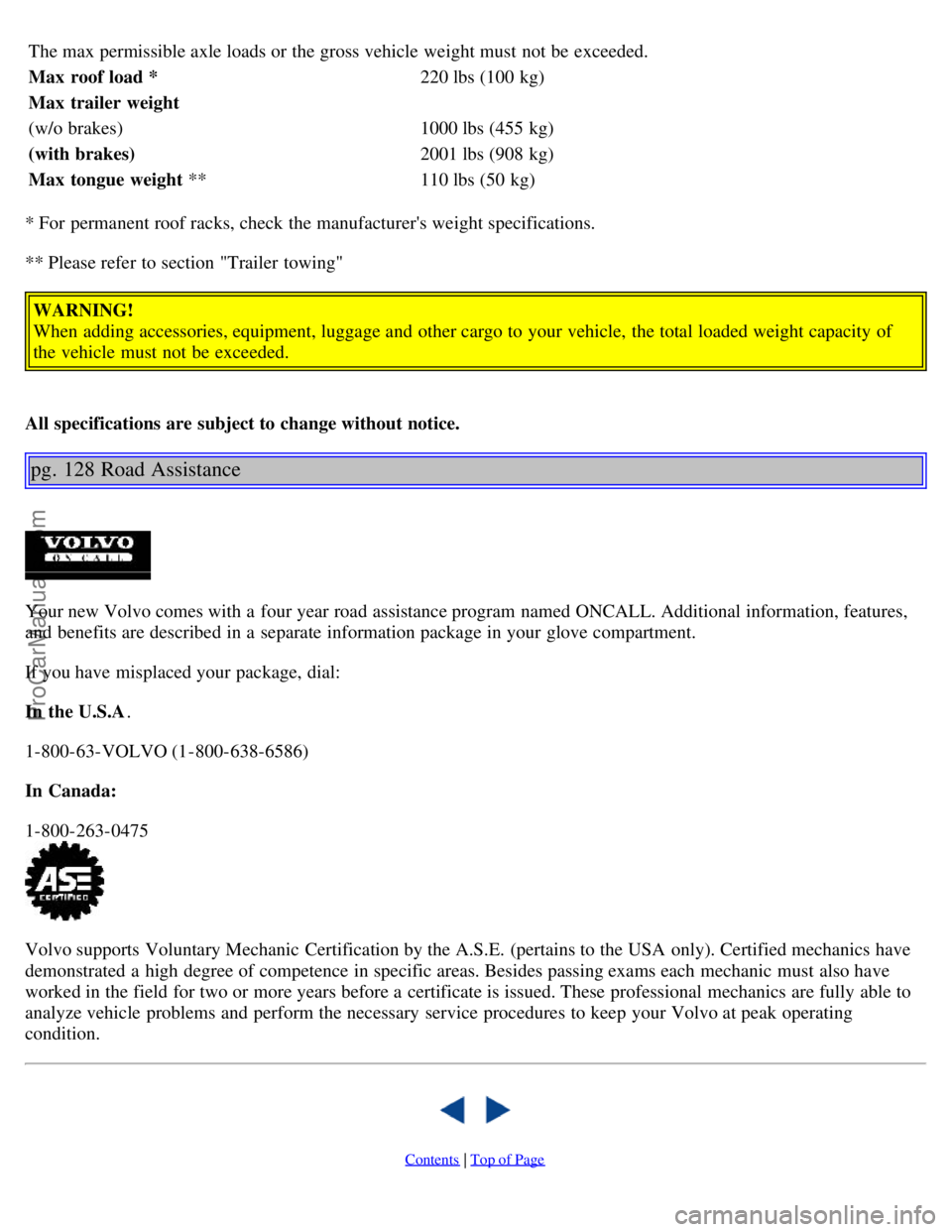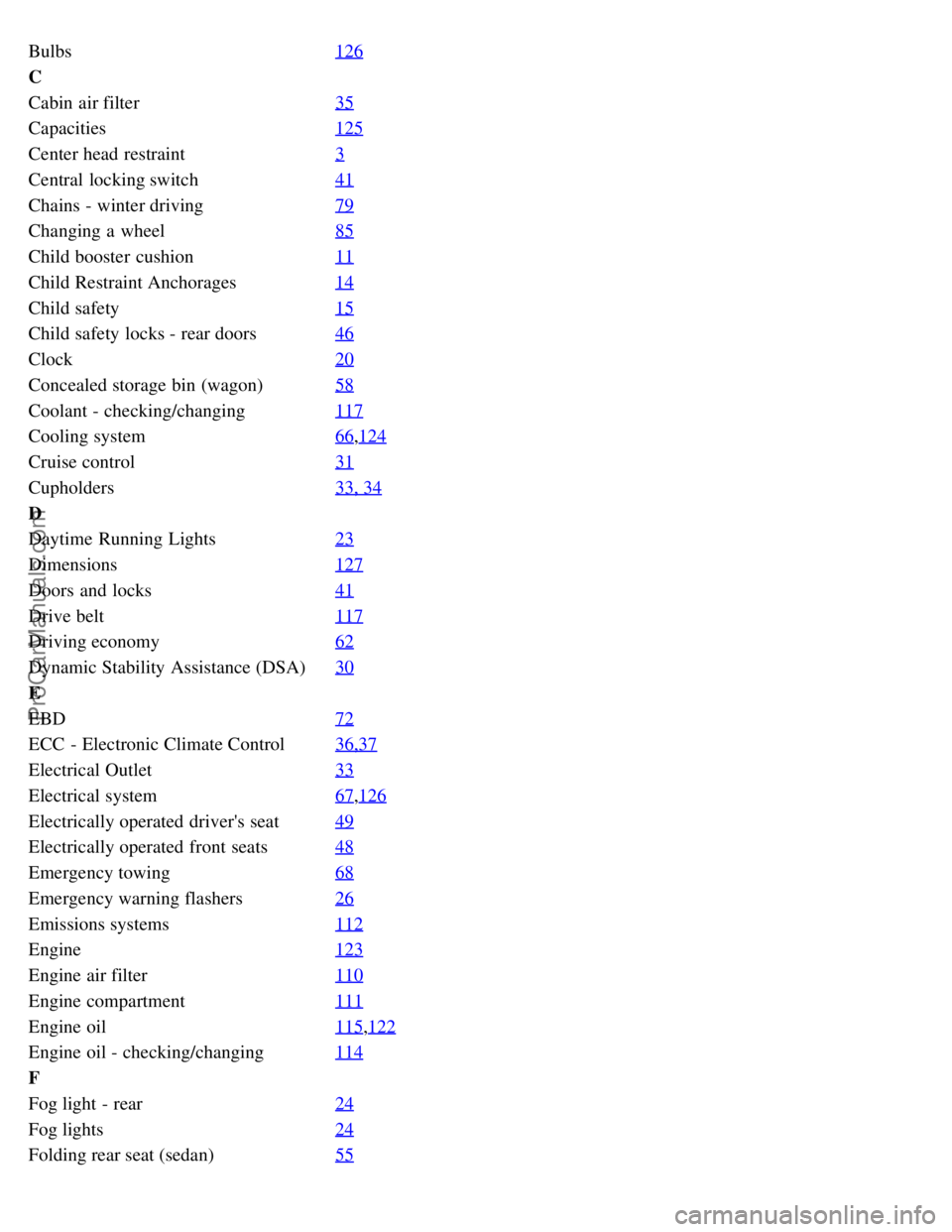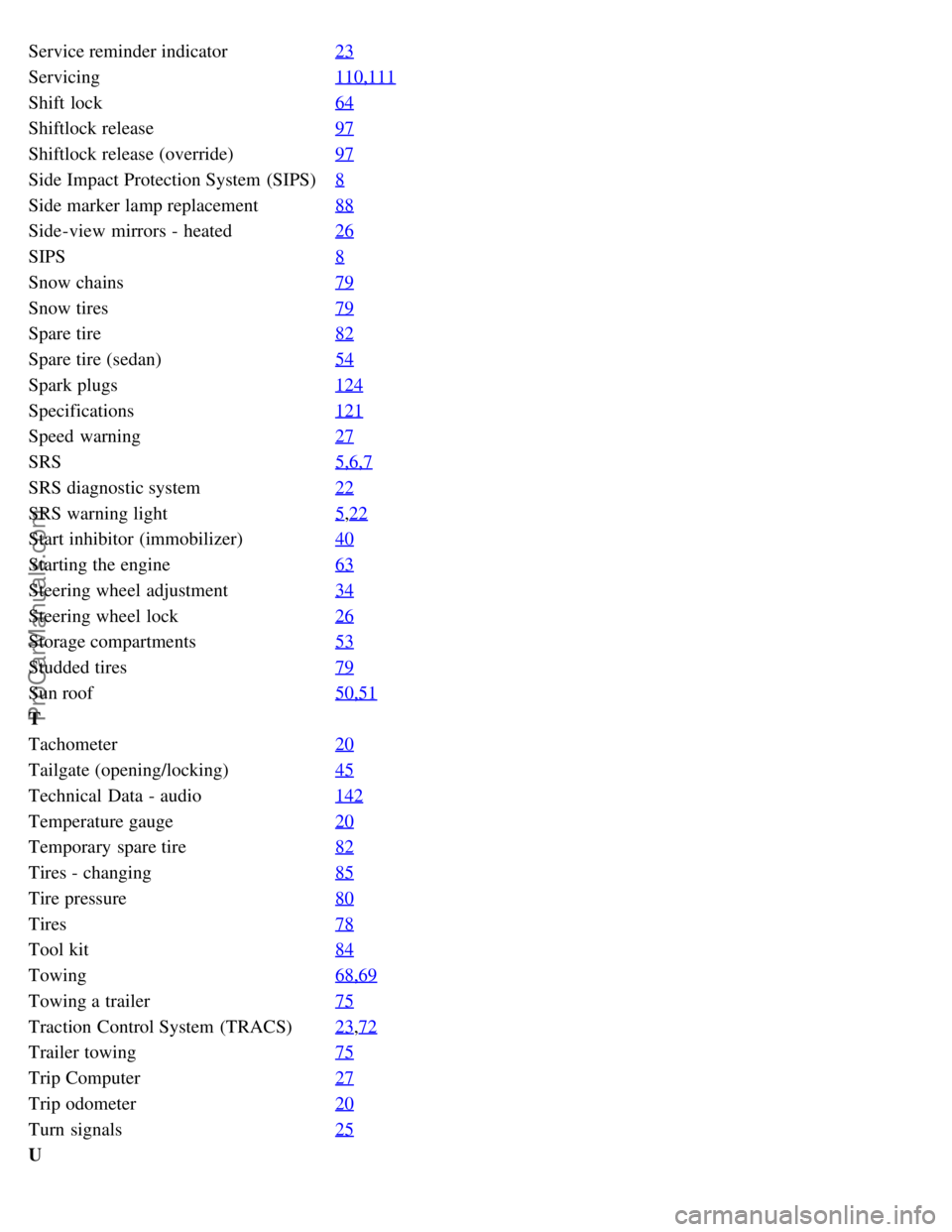tow VOLVO V4 2001 User Guide
[x] Cancel search | Manufacturer: VOLVO, Model Year: 2001, Model line: V4, Model: VOLVO V4 2001Pages: 87, PDF Size: 2.34 MB
Page 54 of 87

· Tar spots can be removed with kerosene or tar remover after the car has been washed.
· A stiff-bristle brush and lukewarm soapy water can be used to clean the wiper blades. Frequent cleaning improves
visibility considerably.
· Wash off the dirt from the underside (wheel housings fenders, etc.).
· In areas of high industrial fallout, more frequent washing is recommended.
CAUTION: During high pressure washing, the spray nozzle must never be closer to the vehicle than 13" (30 cm). Do
not spray into the locks.
· When washing or steam cleaning the engine, avoid spraying water or steam directly on the electrical components or
toward the rear side of the engine.
· After cleaning the engine, the spark plug wells should be inspected for water and blown dry if necessary.
Suitable detergents
Special car washing detergents should be used. A suitable mixture is about 2.5 fl. oz. (8.5 cl) of detergent to 2.6 US
gal. (10 liters) of warm water. After washing with a detergent the car should be well rinsed with clean water.
WARNING!
· When the car is driven immediately after being washed, apply the brakes several times in order to remove any
moisture from the brake linings.
· Engine cleaning agents should not be used when the engine is warm. This may constitute a fire risk.
NOTE: When washing the car, remember to remove dirt from the drain holes in the doors and sills. Bumpers: Wash
the bumpers with the same cleaning agent used on the rest of the car. Never clean the bumpers with gasoline or paint
thinner. Difficult spots can be removed with denatured alcohol. To avoid scratches, do not dry the bumpers with paper.
pg. 102 Automatic car washing, Polishing and waxing
Automatic washing simple and quick
Brushless car washes are recommended. An automatic wash is a simple and quick way to clean your car, but it is
worth remembering that it may not be as thorough as when you yourself go over the car with sponge and water.
Keeping the underbody clean is most important, especially in the winter. Some automatic washers do not have
facilities for washing the underbody.
Before driving into an automatic wash, make sure that side view mirrors, auxiliary lamps, etc., are secure, otherwise
there is risk of the machine dislodging them. You should also lower the antenna (sedans).
We do NOT recommend washing your car in an automatic wash during the first six months because the paint
will not have hardened sufficiently.
Polishing and waxing
Normally, polishing is not required during the first year after delivery, however, waxing is recommended.
ProCarManuals.com
Page 55 of 87

Before applying polish or wax the car must be washed and dried. Tar spots can be removed with kerosene or tar
remover. Difficult spots may require a fine rubbing compound.
After polishing use liquid or paste wax.
Several commercially available products contain both polish and wax.
Waxing alone does not substitute for polishing of a dull surface.
A wide range of polymer-based car waxes can be purchased today. These waxes are easy to use and produce a long-
lasting, high-gloss finish that protects the bodywork against oxidation, road dirt and fading.
Note: Polishing removes oxidized paint from the surface. This is normal. Therefore, when polishing, it may be noticed
that traces of paint color remain on the polishing cloth. This is also normal.
Note: Machine buffing is not recommended.
pg. 103 Cleaning the upholstery
Cleaning the upholstery
The fabric can be cleaned with soapy water or a detergent. For more difficult spots caused by oil, ice cream, shoe
polish, grease, etc., use a clothing/fabric stain remover.
The plastic in the upholstery can be cleaned with a soft cloth and mild soap solution.
Leather upholstery/suede-like upholstery (Alcantera™) can be cleaned with a soft cloth and mild soap solution.
For more difficult spots, Volvo offers a leather care kit.
Under no circumstances should gasoline, naphtha or similar cleaning agents be used on the plastic or the leather
since these can cause damage.
Clean only with lukewarm water and mild soap solution.
Cleaning floor mats
The floor mats should be vacuumed or brushed clean regularly, especially during winter when they should be taken out
for drying. Spots on textile mats can be removed with a mild detergent. Make sure the carpets are properly secured in
the fixation points on the floor.
Bear in mind
· Take extra care when removing stains such as ink or lipstick since the coloring can spread.
· Use solvents sparingly. Too much solvent can damage the seat padding.
· Start from the outside of the stain and work toward the center.
pg. 104
ProCarManuals.com
Page 71 of 87

The max permissible axle loads or the gross vehicle weight must not be exceeded.
Max roof load *220 lbs (100 kg)
Max trailer weight
(w/o brakes) 1000 lbs (455 kg)
(with brakes) 2001 lbs (908 kg)
Max tongue weight ** 110 lbs (50 kg)
* For permanent roof racks, check the manufacturer's weight specifications.
** Please refer to section "Trailer towing"
WARNING!
When adding accessories, equipment, luggage and other cargo to your vehicle, the total loaded weight capacity of
the vehicle must not be exceeded.
All specifications are subject to change without notice.
pg. 128 Road Assistance
Your new Volvo comes with a four year road assistance program named ONCALL. Additional information, features,
and benefits are described in a separate information package in your glove compartment.
If you have misplaced your package, dial:
In the U.S.A .
1-800-63-VOLVO (1-800-638-6586)
In Canada:
1-800-263-0475
Volvo supports Voluntary Mechanic Certification by the A.S.E. (pertains to the USA only). Certified mechanics have
demonstrated a high degree of competence in specific areas. Besides passing exams each mechanic must also have
worked in the field for two or more years before a certificate is issued. These professional mechanics are fully able to
analyze vehicle problems and perform the necessary service procedures to keep your Volvo at peak operating
condition.
Contents | Top of Page
ProCarManuals.com
Page 83 of 87

Bulbs126
C
Cabin air filter35
Capacities125
Center head restraint3
Central locking switch41
Chains - winter driving79
Changing a wheel85
Child booster cushion11
Child Restraint Anchorages14
Child safety15
Child safety locks - rear doors46
Clock20
Concealed storage bin (wagon)58
Coolant - checking/changing117
Cooling system66,124
Cruise control31
Cupholders33, 34
D
Daytime Running Lights23
Dimensions127
Doors and locks41
Drive belt117
Driving economy62
Dynamic Stability Assistance (DSA)30
E
EBD72
ECC - Electronic Climate Control36,37
Electrical Outlet33
Electrical system67,126
Electrically operated driver's seat49
Electrically operated front seats48
Emergency towing68
Emergency warning flashers26
Emissions systems112
Engine123
Engine air filter110
Engine compartment111
Engine oil115,122
Engine oil - checking/changing114
F
Fog light - rear24
Fog lights24
Folding rear seat (sedan)55
ProCarManuals.com
Page 86 of 87

Service reminder indicator23
Servicing110,111
Shift lock64
Shiftlock release97
Shiftlock release (override)97
Side Impact Protection System (SIPS)8
Side marker lamp replacement88
Side-view mirrors - heated26
SIPS8
Snow chains79
Snow tires79
Spare tire82
Spare tire (sedan)54
Spark plugs124
Specifications121
Speed warning27
SRS5,6,7
SRS diagnostic system22
SRS warning light5,22
Start inhibitor (immobilizer)40
Starting the engine63
Steering wheel adjustment34
Steering wheel lock26
Storage compartments53
Studded tires79
Sun roof50,51
T
Tachometer20
Tailgate (opening/locking)45
Technical Data - audio142
Temperature gauge20
Temporary spare tire82
Tires - changing85
Tire pressure80
Tires78
Tool kit84
Towing68,69
Towing a trailer75
Traction Control System (TRACS)23,72
Trailer towing75
Trip Computer27
Trip odometer20
Turn signals25
U
ProCarManuals.com